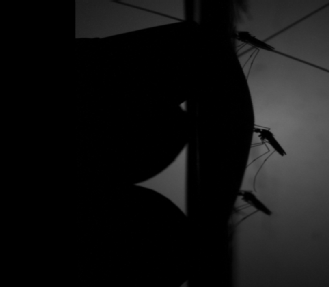Big data battles small insect - Terabytes of mosquito pictures help enhance mosquito netting
 Researchers at the University of Warwick’s School of Engineering are using imaging technologies, that are normally applied to automotive engines and sprays, to image thousands of mosquitoes to help develop better netting and physical protection against the malaria spreading insect.
Researchers at the University of Warwick’s School of Engineering are using imaging technologies, that are normally applied to automotive engines and sprays, to image thousands of mosquitoes to help develop better netting and physical protection against the malaria spreading insect.
The University of Warwick engineers, David Towers, Natalia Angarita and Catherine Towers, are helping entomologist colleagues at the Liverpool School of Tropical Medicine, Philip McCall and Josie Parker, explore the best insecticide treatment and physical design of the protection for sleeping people in areas where mosquitoes are a problem.
In observing how mosquitoes engage with insecticide treated barriers such as netting, researchers have in the past mainly relied on recording just the final landing location, which does not give a full picture of how they approach and handle the protective barriers.
The entomologists at the Liverpool School of Tropical Medicine are carrying out their latest experiments in a swamp in Tanzania. The site has a stable mixed population of mosquitoes, some resistant to insecticide, others not. This is particularly important as insecticide resistance is of significant interest when testing bed nets.
They have built a hut at this site mimicking the typical housing and sleeping arrangements for local people. They need to experiment at night when people are at greatest risk of being bitten by anopheles gambiae mosquitoes: the species responsible for transmission of the malaria parasite which is the most dangerous to humans.
The University of Warwick engineers devised a method that would capture a vast amount of data on the behaviour of the tiny mosquitoes. Using a modified back lighting technique the insects have been imaged throughout a 2.0 × 2.4 × 1.0 metre volume using illumination in the near infra-red. This is a wavelength that is not perceived by mosquitoes so it does not change their natural behaviour. Two cameras are positioned so each captures images at a rate of 50 per second. For every hour of operation 360,000 images are captured, each taken at 4 million pixels, or 1.4 TerraBytes (TB) in total size.
Until now there was no software capable of analysing such a large number of high resolution images, so it had to be specially written by the Warwick Engineers and it has now been used to process over 50 TB of data so far.
University of Warwick engineering researcher Professor David Towers said: “There is a lot of interest in the analysis of so-called ‘big data’ – here we have the added complexity of capturing information from the field with everything powered from petrol fuelled generators and we need very robust algorithms to be tolerant of the natural variability in behaviour exhibited by wild mosquitoes”.
The current phase of the research grant is nearing its conclusion and some initial findings are published today Tuesday 1st September 2015 in Nature Scientific Reports. The indications show that the mosquitoes do not realise a net is treated before they touch it and future research will build on these findings.
Notes for editors
- The full paper in Nature Scientific Reports is entitled Infrared video tracking of Anopheles gambiae at insecticide treated bed nets reveals rapid decisive impact after brief localised net contact. Liverpool School of Tropical Medicine (LSTM) entomologists Philip McCall and Josie Parker are the lead authors.
- This work is part of a €12M research project called AvecNet (www.avecnet.eu), funded by an FP7 grant and brings together a multidisciplinary team of European and African experts including biologists, engineers, epidemiologists, social scientists. The optical engineers at the University of Warwick, David Towers, Natalia Angarita and Catherine Towers, are working with entomologists at Liverpool School of Tropical Medicine (LSTM), Philip McCall and Josie Parker.
- The researchers are pleased to have received a further £0.9M support from the Medical Research Council (MRC) for their next project. The new experiments will use eight cameras, collecting up to 10TB of data per hour, to map not just the sleeping area, but the hut as a whole. This will enable the team to fully map the behaviour of the mosquitoes as they approach their targets.
- A MRC Confidence in Concept grant has also been awarded to build the innovative new net which was patented as an outcome from the current research. The team are hoping to quantify the effectiveness of the net in the laboratory or at the field site.
For further information please contact:
Professor David Towers, School of Engineering
University of Warwick
Email d.towers@warwick.ac.uk
and Mobile number available from Tom Frew
or
Tom Frew, International and Science Press Officer – University of Warwick:
a.t.frew@warwick.ac.uk
+44(0)7785433155
PR305 PJD 1st September 2015
